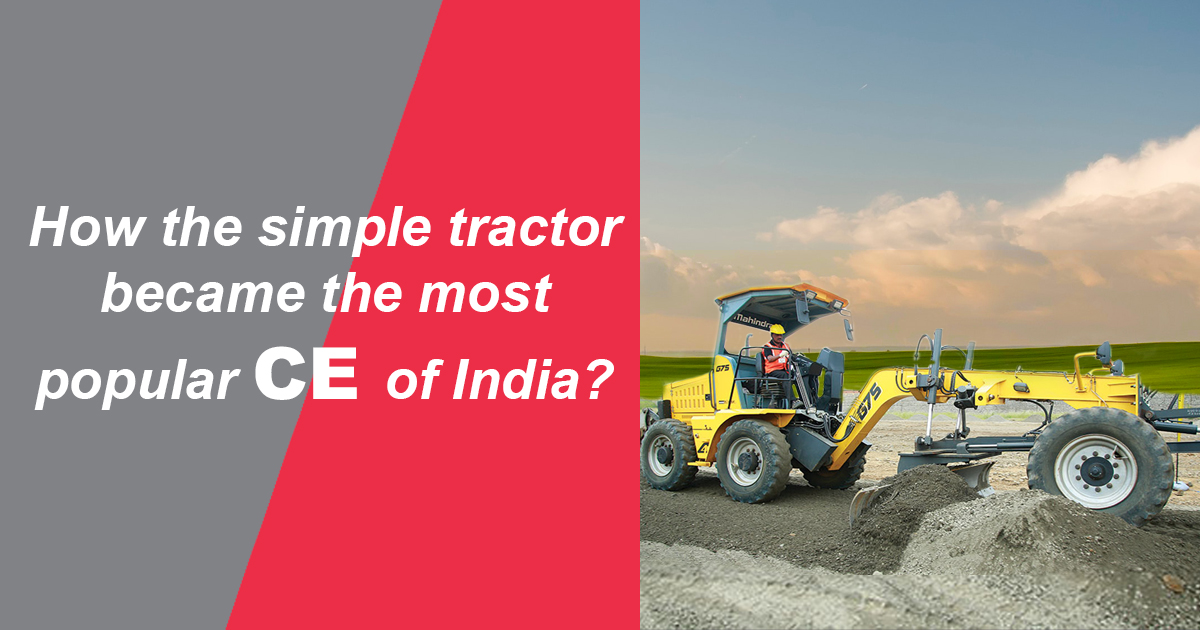How the Simple Tractor Became the Most Popular CE of India?
Backhoe Loaders (BHLs) also called as the loader backhoe, backhoe loader or tractor backhoe, are heavy equipment that essentially consist of a tractor fitted with a bucket on the front and a small backhoe on the back. BHLs which are one of the most important Construction Equipment (CE) found today at any jobsite have a very interesting history. In fact, the history of BHLs is as interesting as the equipment itself. Here, it is to be noted that although based on a tractor, BHLs were and are almost never called a tractor when both the loader and the backhoe are permanently attached. So, here is a look at how a simple tractor backhoe became the most popular CE of India.
History of BHLs
All thanks to the development of the hydraulic technology that a tractor-mounted backhoe became practical for usage in the construction segment. That said, basically, the idea of BHLs developed separately in the US and UK.

The earliest documented hydraulic backhoe was built in the US by Vaino J Holopainen and Roy E Handy Jr in 1947 and it became the foundational product of Wain-Roy Corporation of Hubbardston, Massachusetts, United States. It was in April 1948 that Wain-Roy Corporation sold the very first all hydraulic backhoe which was mounted to a Ford Model 8N Tractor. In the same year i.e., 1948, the company JCB in UK, founded by Joseph Cyril Bamford, launched the first hydraulic loader and followed that in 1953 with a backhoe with a 180° slew, fitted to a tractor. Thus, in 1953, JCB developed the world’s first BHL by adding a backhoe onto the back of a Major Loader i.e., essentially a Fordson tractor with a hydraulic excavator at the rear, a Major Loader at the front and an optional cab. Until this time, all the equipment had a common theme i.e., they were built by companies entirely separate from the manufacturers of the tractors for which they were designed.
Then a major change came in 1957 where while JCB introduced the first dedicated BHL (which was however, just a prototype), CASE Construction produced the first integrated tractor loader/backhoe in the USA (whereby all the components were manufactured and warranted by the same manufacturer). These were purpose-built, heavy-duty wheel tractors with the loaders and backhoes to go on them. This put the entire machine under the coverage of a single warranty and gave rise to their widespread use in the construction segment.
After that, the American company Hy-Dynamic, a division of Bucyrus-Erie, introduced the second purpose-built BHL in 1959 i.e., the Dynahoe Model A. The company marketed the Dynahoe as the only purpose-built BHL as previously all American backhoes were merely farm tractors fitted with front loader and rear backhoe attachments. Later, it was in 1970 when Hy-Dynamic became the first company to incorporate a four-wheel drive system into their BHLs, allowing these models to move over almost any terrain with little difficulty. However, it was not until 1971 that the first ‘over centre’ BHL was introduced by CASE Construction. This machine was better than all the previous versions in all aspects as it offered a much smoother ride and better maneuverability than the older models. After that, as they say that rest was history. Gradually, various other companies emerged on the scene and started manufacturing BHLs.
Origins in India and the present
In India, Backhoe Loader was introduced by the company Escorts Construction Equipment in collaboration with JCB in 1979-80. It was the first tyre-mounted excavation machine in the country as there were no mini or tyre-mounted excavators available at the time. Later, its affordability and multi-application versatility made it a popular machine for years to follow. Today, BHLs accounts for nearly 65 per cent of the CE segment.
At present, there are many companies in India manufacturing BHLs suited for the Indian needs. One of the most noted companies today is Mahindra Construction Equipment (MCE), a part of US $17.8 billion Mahindra Group, which started its business in 2011 in India with its revolutionary BHL—Mahindra EarthMaster. Bidding goodbye to the dated technologies employed by the earthmoving contractors in India, MCE offers next-generation BHLs backed by the engineering capabilities, manufacturing strength, distribution reach and after-sales service of Mahindra & Mahindra. Highly reliable and safe, the BHLs are built to suit the Indian needs and can withstand Indias rough terrain and heavy usage. The equipment comes with intelligent communication system i.e., DigiSense, Joystick controls, 6-in-1 bucket option and various attachments and has Banana Boom, allowing for greater depth of digging and a bigger working circle. The equipment also offers best-in-class fuel efficiency and is environment-friendly and possesses the capability of sustaining extended service intervals among others. Mahindra EarthMaster is available in the following variants: EarthMaster VX, EarthMaster SX, EarthMaster SX 90 4WD, EarthMaster SXL and EarthMaster SX- 4WD.
What makes BHLs most popular CE in India?
BHLs are most popular CE in India because they are highly versatile machines and can be used for multiple purposes and can easily travel on roads. In fact, they can be used for numerous applications including digging, demolitions, excavating, breaking asphalt, laying roads, transporting materials, levelling, loading and much more at the jobsite with additional attachments. That said, there are clear benefits of using BHLs at the construction site. These include improved quality, timeliness, better project financials and safety among others.
Given that, due to the rise in infrastructural development projects and increased spending on the construction activities, the BHL market in the country is only expected to grow further in future. In fact, as per Off-Highway Research, sales of BHLs in India is expected to increase from the 21,192 units sold in 2015 to 42,000 machines by 2020, a significant increase by any standards. Thus, undoubtedly, BHLs are the most popular CE in India and will continue to be so in the foreseeable future.









